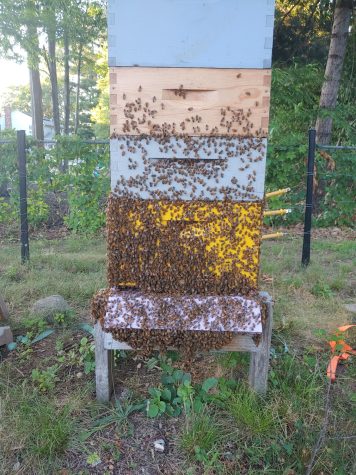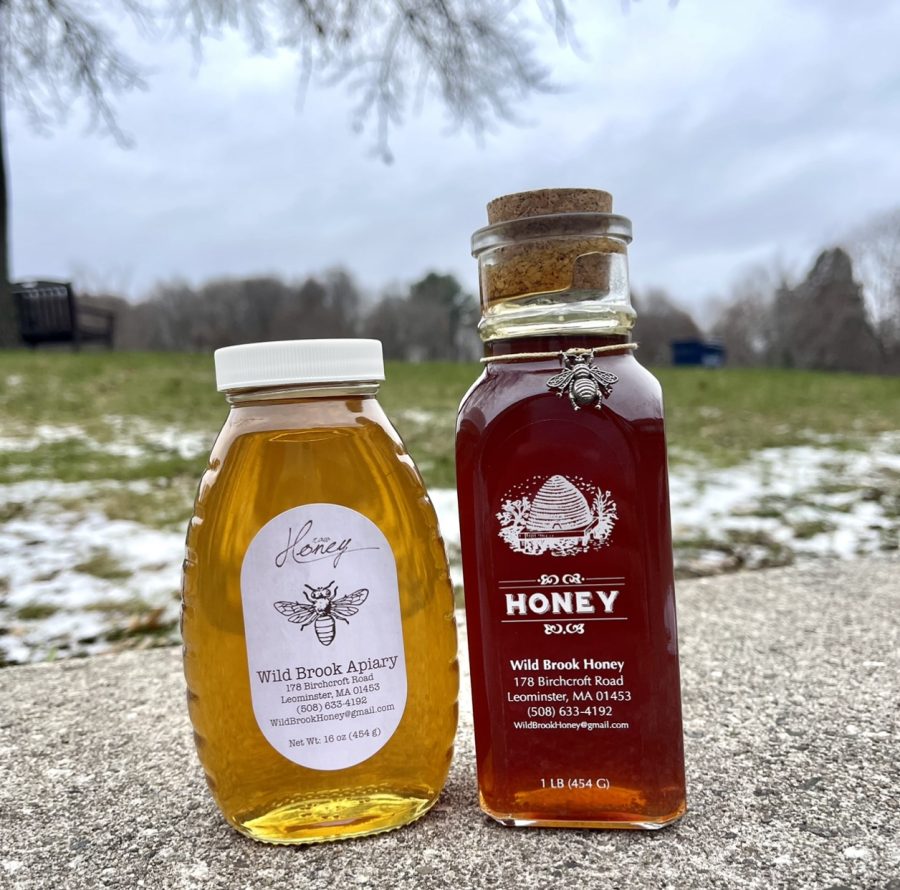Science Teacher, Beekeeper, and Entrepreneur: Mr. Fontaine Discusses Everything Bees
Wild Brook Honey: A local apiary company in the Worcester County area.
January 19, 2023
Mr. Fontaine, Science Department Head at Westborough High School, has been beekeeping since 2015 and has created his own apiary company called Wild Brook Honey. It all began in 2015 when The Umass Medical Center offered a beekeeping night class where all science teachers decided to sign up. Now in 2023, two teachers have continued their beekeeping journey, Mr. Fontaine and fellow science teacher Mrs. Hilfinger.
Mr. Fontaine explains that beekeeping is a year-long process that entails various tasks. In the spring, the queen bee lays a larger quantity of eggs, so he has to try to prevent illnesses and swarming as the hives build up. Mr. Fontaine also has to ensure that the hives have enough food. When there is no nectar flow or stored honey, he needs to feed them a sugar syrup solution and a pollen substitute. Most wait until the end to harvest all the honey, but Mr. Fontaine shares that he likes to collect different flavors, so he harvests at different times. Fontaine shares that he has 8 locations throughout northern Worcester County including the high school.

Before the winter, he must prepare the bees and make sure the hives are insulated and that the bees have enough storage to survive. In the winter, he visits the hives every two weeks to make sure they have enough food and uses sugar bricks instead of the sugar syrup solution. These tasks are important because if the hives run out of food, they will all starve and die off. Preventing viruses and pests are also necessary because if they latch onto the bees they won’t survive the winter. Mr. Fontaine shares that he entered the winter with 72 hives. Bees do not hibernate, but rather form a cluster on days that drop below 50 degrees. On days that reach higher than 50 degrees, they relieve themselves from the hives. They can go over a month without relieving themselves.
Mr. Fontaine also explains that there is no organic honey in the United States. If there is any on shelves in stores, it comes from another country that has different regulations. The U.S. only produces raw honey. Raw honey comes straight from the honeycombs. It is produced in the hive by the bees and is never heated, filtered, or touched by human hands. However, Mr. Fontaine explains that he uses organic methods to treat his hives for mites.
There are several key factors that make each type of honey unique, such as color, flavor profile, and what season it is. Mr. Fontaine produces spring and fall honey. It is important to know that the flavor of honey is affected by different flower nectar. This means that flowers in bloom in the spring play a role in the taste of the spring honey, while flowers in the fall such as asters and goldenrod play a role in the taste of the fall honey.
We were fortunate enough to try Wild Brook Honey’s spring and fall honey and both had key differences. The spring honey was light in color, had a strong floral scent and taste, was smooth, light, and delicate. The taste was creamy and definitely better quality than any other honey we’ve tried. The spring honey would pair amazingly with a cracker spread, fruits, salads, and as a drizzle on desserts such as honey cake or pie.
The fall honey was a dark golden/amber color, had a thicker texture, a woody smell, and a stronger lasting taste on your palette. The honey was sticker and more robust than the spring one. The taste was much more flavorful than typical store options. The fall honey would pair wonderfully with nuts, cheese, and charcuterie boards.
Wild Brook Honey uses classic honey jars and Muth jars for their packaging which is a reproduction of what was used in the 1800s. Muth jars were the first jar to have been specifically made for honey. The packaging for their products is certainly high quality and visually aesthetic. Both jars are secured airtight with either a screw on top lid or a cork. Mr. Fontaine also shares that in addition to honey, he also produces beeswax candles.
Mr. Fontaine is also the advisor for the Bee Club at Westborough High School. The club’s goal is to teach students how to manage honey bee colonies as well as how to install bees into hives. He explains that when you start off, you need to first purchase bees for a thriving hive which is around 10,000 bees. Mr. Fontaine also shares that honey bees are not native to the U.S. and hopefully by the summer he will have 150 hives.

Wild Brook Honey also offers a variety of size options. Starting with the 2 oz honey bears that are priced at $3, 1 pound jars for $12, 5 pound jars for $30, and Muth jars for $16. Wild Brook Honey is sold at 11 different locations with a few in and near the Westborough community. Such as Eisele Kaye Glassworks in Westborough and Ed Hyder’s Mediterranean Marketplace in Worcester.









